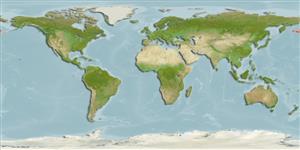Klassifizierung / Names
Namen | Synonyme | Catalog of Fishes(Gattung, Arten) | ITIS | CoL | WoRMS | Cloffa
>
Perciformes/Cottoidei (Sculpins) >
Liparidae (Snailfishes)
Etymology: Careproctus: Greek, kara = face + Greek, proktos = anus (Ref. 45335); zachirus: Named for the long pectoral fin..
Environment: milieu / climate zone / depth range / distribution range
Ökologie
seewasser bathydemersal; tiefenbereich 150 - 850 m (Ref. 51661), usually 400 - 500 m (Ref. 56456). Deep-water
Northwest Pacific: Amchatka Pass, Alaska.
Size / Gewicht / Alter
Maturity: Lm ? range ? - ? cm
Max length : 32.0 cm TL Männchen/unbestimmt; (Ref. 56456); common length : 22.0 cm TL Männchen/unbestimmt; (Ref. 56456); max. veröff. Gewicht: 500.00 g (Ref. 56456); max. veröff. Alter: 7 Jahre (Ref. 56456)
Kurzbeschreibung
Morphologie | Morphometrie
Rückenflossenstacheln (insgesamt): 0; Rückenflossenweichstrahlen (insgesamt): 51-53; Afterflossenstacheln 0; Afterflossenweichstrahlen: 43 - 45; Wirbelzahl: 56 - 58. Pectoral fin distinctly notched; caudal fin broad, continuous with dorsal and anal fins for about two-thirds of its length, end of dorsal fin forming notch on caudal fin (Ref. 12700). Body pinkish; eye black; posterior part of upper pectoral fin lobe stained with black in both outer and inner sides; black bands of dorsal and anal fins jointed each other in the middle of the caudal fin (Ref. 12700).
Life cycle and mating behavior
Geschlechtsreife | Fortpflanzung | Ablaichen | Eier | Fecundity | Larven
Kido, K., 1985. New and rare species of the genus Careproctus (Liparididae) from the Bering Sea. Jap. J. Ichthyol. 32(1):6-17. (Ref. 12700)
IUCN Rote Liste Status (Ref. 130435)
Bedrohung für Menschen
Harmless
Nutzung durch Menschen
Fischereien: nicht kommerziell
Mehr Information
NamenSynonymeMetabolismusRäuberÖkotoxikologieFortpflanzungGeschlechtsreifeAblaichenSpawning aggregationFecundityEierEientwicklung
ReferenzenAquakulturAquakultur ProfilZuchtlinienGenetikElectrophoresesVererbbarkeitKrankheitenVerarbeitungNutrientsMass conversion
PartnerBilderStamps, Coins Misc.LauteCiguateraGeschwindigkeitSchwimmstilKiemenoberflächeOtolithsGehirngrößeSehfähigkeit
Tools
Zusatzinformationen
Download XML
Internet Quellen
Estimates based on models
Preferred temperature (Ref.
123201): 3.2 - 3.6, mean 3.5 °C (based on 7 cells).
Phylogenetic diversity index (Ref.
82804): PD
50 = 0.5000 [Uniqueness, from 0.5 = low to 2.0 = high].
Bayesian length-weight: a=0.00692 (0.00380 - 0.01261), b=3.14 (2.98 - 3.30), in cm total length, based on LWR estimates for this species & Genus-body shape (Ref.
93245).
Trophic level (Ref.
69278): 3.4 ±0.47 se; based on food items.
Widerstandsfähigkeit (Ref.
120179): mittel, Verdopplung der Population dauert 1,4 - 4,4 Jahre. (Preliminary K or Fecundity.).
Fishing Vulnerability (Ref.
59153): Low vulnerability (22 of 100).
